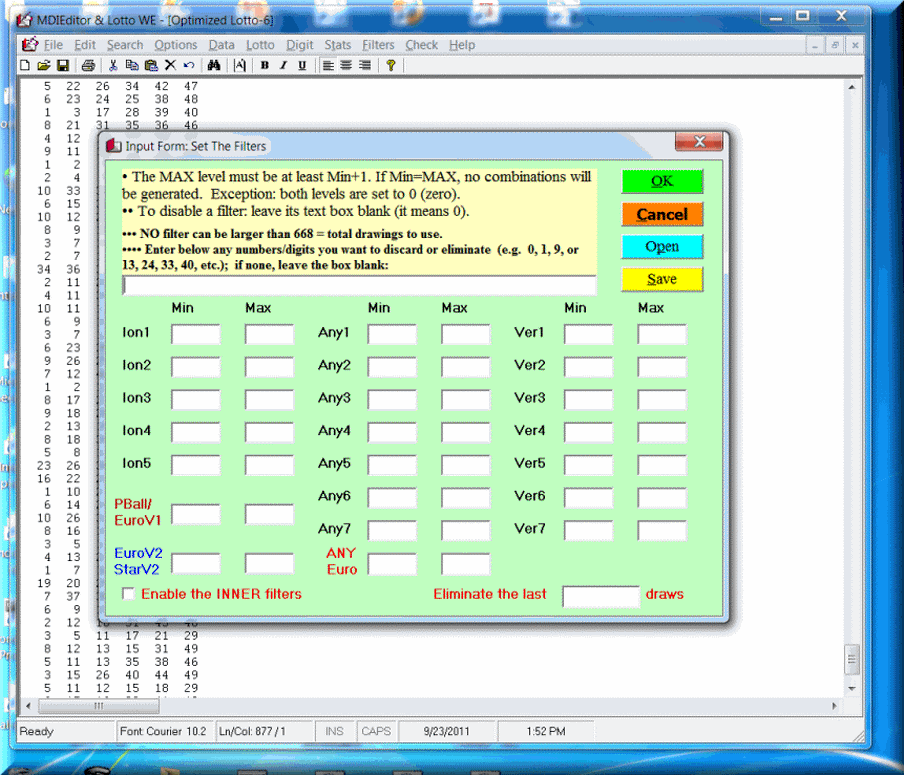
The Best Lottery Software, Lotto Programs, Loto Software, Loteria, Systems
Proposal of Improvements to MDIEditor And Lotto WE



Posted by Karl M. on August 23, 2000.
In Reply to: Lotto Software, Lottery Software, Programs: Analysis, Comparison, Gail Howard posted by Ion Saliu on August 23, 2000.
Thanks, Ion. I don't disagree with what you said. Algthough I still am a bit hazy on how to manually input for your any/ver filters, I like that the any/ver aspect of your program the most. I have the impression that we input the any/very output from the lotto 6 calculation into the max input area; however, I still do not quite understand what to input into the min input area. I can hear you now, "Read the directions again." Surely I will. Purely for the love of science and money, I incorporated a slight "modification" into your MDIEditor and Lotto input routine that might make its output even more reliabl...or "fine tuned". I That's my hypothesis. I await the empirical evidence, so I will say no more of it at this time. I could not have even had the idea if I had not been made aware of your awesome body of knowledge. Thanks, again. I will say this however, one might call my "modification" a paradigm shift. That's all folks.

KM
: • Some informed me that Gail Howard’s approach has some similarities to my lottery strategy presented on the Lottowin.htm page. I understand, however, that her method is not based on the fundamental formula of gambling. Nor is her method based on other math formulas. Rather, Gail Howard’s lottery strategy appears to be based on observation. From what Karl shows, Gail Howard’s lottery does some advanced statistical analyzing and reporting. The software is expensive nonetheless, especially when wheeling is bundled.
My lottery and lotto software offers also other helpful statistical elements: the SKIP charts and ‘WORST PAIRINGS”. The two elements are a lot more useful than any charts or graphical patterns. The skip charts can be used even more efficiently in conjunction with the fundamental formula of gambling (FFG). I showed that in a lotto 6/48 (or 6/49) game, every number will repeat within 6 drawings in 50% of the situations. Let’s dig deeper into this statement. So, the probability of a lotto 6/49 number to repeat is ½ times 1/6 (the number will repeat after 1, or 2, or 3, or 4, or 5, or 6 drawings). The combined probability is ½ x 1/6 = 1/12. But the lottery draws 6 numbers, therefore the probability to get all 6 numbers repeating after 1 to 6 drawings is: 1/12 x 1/12 x 1/12 x 1/12 x 1/12 x 1/12 = 1/12 to the power of 6. The result is 3.35 in 10 million, or about once in 1,000,000. Well, the odds are better than playing 6 random numbers (1 in 13,983,816), but they are still impractical. Which brings us to the second lotto myth: the “wheels’.
No player can ever play the lottery profitably without filtering, period. The statistical analyses can only take you so far. The “static wheels” are almost immobile. The only tools that can eliminate a huge number of lotto combinations are the LOTTERY FILTERS. My software uses a large number of lottery filters. I want to make it clear: Anyone can think of any filters he/she likes. Nobody has a given talent to “discover” or “invent’ lottery filters. There must be countless lottery filters in this universe. I simply came up with a bundle of filters and implemented them in my software. (I don’t want to say that they are very easy to comprehend, for everybody, and from the beginning.) I showed you how to use the filters to even improve “static lotto wheels” (as shown for the WHEEL49.36 case). I also strongly advised that the best way to wheel lotto numbers is to do it ‘dynamically” (using WHEEL-6 in conjunction with a set of filters). If you master the W6 reports, you are guaranteed to win, including the big one.
Even if you could copy and paste the lottery data, Platinum Plus would still require all digits below 10 to have a zero in front of them otherwise it rejects all the lottery data. So, you'd still have to do a great deal of manual input. Frankly I got better results with inputing lottery data into my SPSS statistical analysis software. I suppose SAS stat. software would work equally well or whatever you may have.
Lottery Advantage Software, in contrast, is vastly superior to Platinum Plus. While it does the typical descriptive statistics like mean, median, mode, range, min., max., etc.; it also has over 50 charts devoted to number pattern analysis. I personally have a fascination with repeating cycles as per my last posting, and this program covers them in a vast amount of ways. Interestingly, this Lottery Advantage program costs about half--her wheeling program(s) cost extra--what Platium Plus costs; but Lottery Advantage seems to me to be vastly superior. And I like the fact that they download all your local 5 and 6 number lottery/lotto data into your software for free. Ion's software is a terrific deal. His Medieditor software is worth at least as much as Platinum Plus. I particularly like his any/ver theory, even if I find the wheeling filter methodology confusing. I personally don't use it, and that solves that problem. Regardless, I have analyzed over eight years worth of data, and there does seem to be consistent, albeit imperfect, performance with particular numbers predicting certain other numbers.
: Karl M.

Resources in Lottery, Software, Systems, Lotto Wheels, Strategies

In this thread of lottery software analysis, comparison, review:


Home | Search | New Writings | Software | Odds, Generator | Contents | Forums | Sitemap
